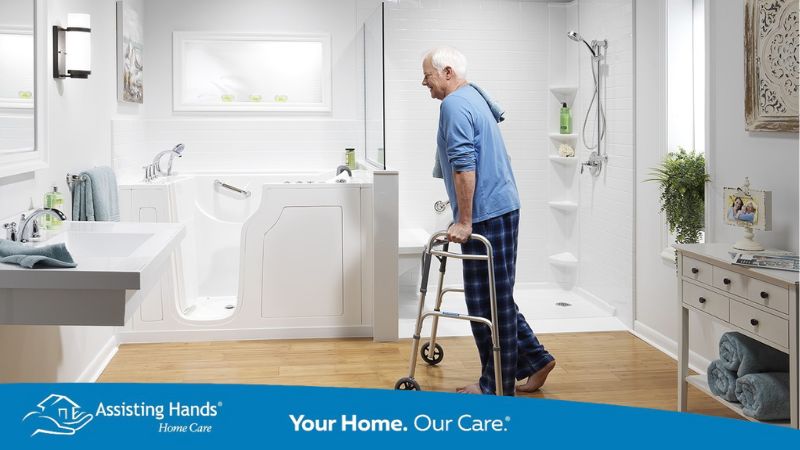
Summary: Walk-in tubs help seniors bathe safely and comfortably, especially those with mobility or health issues. While they can be pricey, programs like Medicaid, VA benefits, and nonprofit support may help cover the cost. Pairing a walk-in tub with care from Assisting Hands Home Care makes aging at home easier and safer.
Growing older often comes with physical and mobility challenges, making bathroom falls more common among seniors. Navigating slippery floors and high tub walls can result in dangerous accidents. Installing a walk-in tub is an effective solution to mitigate bathroom hazards. Here’s how seniors can qualify for a free walk-in tub with financial assistance options.
Bathroom Falls and Their Impact on Seniors
Each year, nearly 550,000 seniors aged 65 and older suffer injuries due to bathroom falls. According to the Centers for Disease Control and Prevention (CDC), 80% of these injuries occur near toilets, tubs, and showers.
Bathroom falls can cause a wide range of injuries, including sprains, fractures, bruises, and even more severe conditions. In many cases, seniors who fall are unable to call for help, potentially leading to dehydration or hypothermia from prolonged exposure to the floor.
The emotional and psychological impact is also significant. Falling in the bathroom can lead to frustration, reduced self-esteem, and a fear of falling again. When injuries are severe, it can result in the loss of independence.
What is a Walk-In bathtub?
Fortunately, families can modify the bathroom to make this area safer for seniors. One adaptation is the walk-in bathtub. This special tub features a watertight door that allows the elderly to enter and exit the tub without having to climb over a high tub wall.
Why Should Seniors Consider a Walk-In Bathtub?
A walk-in tub offers older adults several advantages. One of the most important is the reduced risk of falls. As mentioned, the walk-in tub is designed so that seniors step in and out without precariously maneuvering over the high threshold typical of a standard bathroom tub.
Walk-in tubs are manufactured with built-in seating, which reduces the senior’s risk of falling while they stand inside. The slip-resistant features of walk-in tubs provide the elderly with sure footing to further reduce the risk of slips and falls on the slick, wet tub floor.
In addition to promoting maximum safety, walk-in tubs offer water therapy. Seniors fill the tub with warm water and soak inside to experience spa-like relaxation. Some tub models come with heating pads and jets, therapeutic features that help older adults unwind.
Aging people who live with arthritis or other age-related health conditions benefit from the warm water that soothes pain, fatigue, and stiffness. A soak inside the walk-in tub relaxes muscles, reduces inflammation associated with arthritis, and eases pressure on stiff joints.
Due to the safety and therapeutic benefits, a walk-in tub is an investment in the senior’s future. Installing a walk-in tub increases the elderly individual’s independence while bathing. In short, a walk-in tub is a bathroom modification that facilitates aging in place.
The Best Candidates for Walk-In Tubs
Walk-in tubs are an ideal solution for many seniors, especially those dealing with physical challenges or health conditions that make bathing difficult or dangerous. Here are the types of seniors who can benefit the most from installing a walk-in tub:
- Seniors with Mobility Issues: Whether due to arthritis, muscle weakness, or conditions like Parkinson’s disease, seniors who struggle with balance or movement are at an increased risk of bathroom falls.
- Seniors Recovering from Surgery or Injury: After procedures like hip or knee replacements, seniors may experience limited mobility during recovery.
- Seniors with Vision Impairments: For those with limited eyesight, navigating a traditional bathtub can be challenging.
